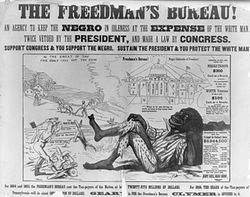I’m revising my textbook once again and I’m struck every time I do it that the chapter on Reconstruction appears in both Volume 1, designed for the first half of the survey, and volume 2, designed for the second.
This time, I’m revising the book at the same time I’m freshening up my syllabus for the fall. We in the history department at UIC have decided to rename the second half of the survey “From Industrialization to Globalization,” thus firmly implying that the course start with the Industrial Revolution, thereby moving Reconstruction to the first half. The logic there, which I think is sound, was that you can’t really understand Reconstruction without understanding the Civil War, and thus they must be taught together.
Is this right?
Can you effectively teach Reconstruction without having taught the Civil War? Is there some reason to include Reconstruction as a complete unit in the second half of the survey? Or is part of the first half, done and dusted? I’m curious to hear how others have done it.
I remember right after I taught Reconstruction last year, my colleague Rick Fried, who used the same classroom right after me, walked in as I was finishing Reconstruction and said, “hey, you cheated, you can’t start there.”
Was he right?





I suppose it depends on how you structure your course and what you emphasize, but I can’t imagine teaching the second half of the survey without starting with Reconstruction. How do things like the Civil Rights movement and the conservative backlash against encroaching federal intervention make sense without the historical context of Reconstruction and Redemption?
It does seem problematic to divorce Reconstruction from the Civil War, but, in my opinion, not nearly as problematic as divorcing Reconstruction from post-1945 US history.
Anonymous,
Well, I suppose if you’re interested in the legalistic basis of the civil rights movement, you’d have to go back to the Civil War and Reconstruction. And I hear your complaint about understanding the conservative backlash, but you can chart the rise of Jim Crow to the 1880s and especially the 1890s, as responses to the threat that the Populists might fuse the working-classes together–and that’s why all those laws get passed in that “nadir of race relations” in America. Like Ed says, you can tie segregation to “the New South” and forget Reconstruction altogether. But again, I’m not certain I agree with this just yet…
Kevin
Although I love Reconstruction and think it (rather than the civil war) is the linchpin of 19th-century US, I see the point to this. We often teach the first half of the survey without huge amounts of European history now (which wuold have been unthinkable 50 years ago) and I think the place of race and the nation could be subsumed into the ‘industrialization’ section. The “New South” could become the beginning of the second half. And let’s face it, the 20th century has been so gigantic in size that it seems to need an entire course.
Well, we are always breaking a chain of causation when we pick a discrete point in which to start telling our story. When we skip Reconstruction, we will definitely be missing something (legally and spiritually) in relation to the CRM. If we start with 1900 (which is my institution’s choice—breaking the U.S. survey into three centuries), then I can’t tell fun stories about settling the West (and its closing)—and I miss fun stuff about urbanization and industrialization. So, pick your poison.
As for me, I favor an approach where you start with a date or event/s in which you hope to end the course, then work backwards. If you start with 9/11, then there is a story you can tell in reverse about globalization, imperialism, the Cold War, and the history of oil. Each choice dictates certain retroactively important starting points. – TL